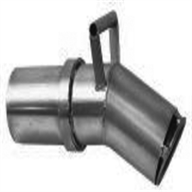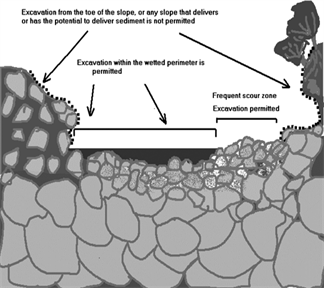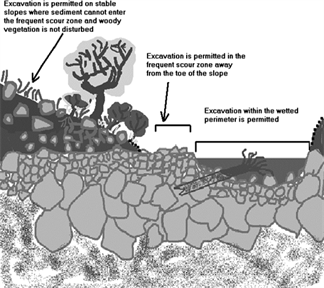(1) Description: Mineral prospecting involving motorized or gravity siphon equipment are projects that excavate, process, or classify aggregate using small motorized equipment or pumps. Such methods include, but are not limited to, suction dredges, dryland dredges, power sluice/suction dredge combinations, motorized high-bankers or power sluices, trommels, and spiral wheels. These projects also include methods using gravity siphons that supply water for excavating, processing, or classifying aggregate by means of vacuum created by water flowing through a tube or hose, such as gravity dredges or nonmotorized high-bankers. Bulb snifters are not considered motorized or gravity siphon equipment. The rules in this section apply to using motorized or gravity siphon equipment. See WAC 220-660-300 for mineral prospecting with other types of equipment.
(2) Fish life concerns: Mineral prospecting involving motorized or gravity siphon equipment can harm fish life and habitat that supports fish life.
(a) Direct impacts can include:
(i) Mortality from the physical effects of disturbing eggs or fry incubating within the bed;
(ii) Mortality from passing vulnerable fish through equipment; and
(iii) Lower environmental productivity resulting from habitat modifications such as altered stream beds or lowered water quality.
(b) Indirect impacts can include changes in food resources and human disturbances.
(c) The department minimizes impacts by restricting the type of mining equipment allowed, limiting excavation zones within streams, and setting allowable timing windows.
(d) Aquatic invasive species can be transported on or in motorized and gravity siphon equipment and spread between water bodies. This can harm all life stages of fish life and permanently harm, destroy, or alter ecosystems.
(3) General requirements:
(a) Before conducting any mineral prospecting involving motorized or gravity siphon equipment, a person must obtain the approval of the department through the issuance of a standard, single-site written HPA or standard, multisite written HPA as described in WAC 220-660-050. The department must deny an HPA when, in the judgment of the department, the project will result in direct or indirect harm to fish life, unless enough mitigation can be assured by provisioning the HPA or modifying the proposal. The department may apply saltwater provisions to written HPAs for tidally influenced areas upstream of river mouths and the mainstem Columbia River downstream of Bonneville Dam.
(b) The department will determine the authorized work time for mineral prospecting activities involving motorized or gravity siphon equipment that discharge water to surface or ground water per WAC 220-660-110.
(c) Nothing in this chapter relieves a person of the duty to obtain landowner permission and any other required permits before conducting any mineral prospecting activity.
(4) Aquatic invasive species prevention:
(a) All motorized or gravity siphon equipment that has been used in waters outside of Washington state must be inspected for the presence of aquatic invasive species by an authorized department employee or agent before being used in waters of the state.
(b) All motorized or gravity siphon equipment used in any water of the state must be decontaminated according to department specification prior to use in a different water of the state.
(5) Mineral prospecting involving motorized or gravity siphon equipment:
(a) A person may operate motorized or gravity siphon equipment in waters of the state only with the mineral prospecting equipment limitations identified in this section and during the times identified in the written HPA.
(b) When mining using motorized or gravity siphon equipment, a person may use only hand-held mineral prospecting tools and the following mineral prospecting equipment:
(i) Pans;
(ii) Spiral wheels;
(iii) Concentrators and high-bankers with riffle areas totaling ten square feet or less, including ganged equipment;
(iv) Gravity siphons;
(v) Motorized or nonmotorized suction dredges that have suction intake nozzles with inside diameters that should be five inches or less, but must be no greater than five and one-quarter inches to account for manufacturing tolerances and possible deformation of the nozzle. The inside diameter of the dredge hose attached to the nozzle may be no greater than one inch larger than the nozzle size. See Figure 1;
 |
Figure 1: Suction dredge intake nozzle
(vi) Power sluice/suction dredge combinations, when configured and operated as suction dredges, that have suction intake nozzles with inside diameters that should be five inches or less, but must be no greater than five and one-quarter inches to account for manufacturing tolerances and possible deformation of the nozzle. The inside diameter of the dredge hose attached to the suction intake nozzle may be no greater than one inch larger than the nozzle size. See Figure 1;
(vii) Power sluice/suction dredge combinations, when configured and used as high-bankers or power sluices, that have riffle areas totaling ten square feet or less, including ganged equipment and pump hoses with inside diameters of four inches or less;
(viii) High-bankers and power sluices that have riffle areas totaling ten square feet or less, including ganged equipment, and pump intake hoses with inside diameters of four inches or less.
(c) The Washington department of ecology determines where motorized or gravity siphon equipment listed in the previous provision may be used. Contact the Washington department of ecology water quality program for information about the locations where the use of motorized or gravity siphon equipment is allowed.
(d) The suction intake nozzle and hose of suction dredges and power sluice/suction dredge combinations configured and operated as suction dredges must not exceed the diameters allowed in this subsection (5).
(e) When operating a dryland dredge:
(i) A person may not excavate, collect, or remove aggregate from the toe of the slope. A person also may not excavate, collect, or remove aggregate from an unstable slope or any slope that delivers, or might deliver, sediment to the wetted perimeter or frequent scour zone. See Figures 2 and 3.
 |
Figure 2: Cross section of a typical body of water showing unstable slopes, stable areas, and permitted or prohibited excavation sites when operating a dryland dredge. Dashed lines indicate areas where excavation is not permitted.
 |
Figure 3: Permitted and prohibited excavation sites in a typical body of water under rules for dryland dredging. Dashed lines indicate areas where excavation is not permitted.
(ii) A person must process aggregate collected from upland areas landward of the frequent scour zone only at an upland location landward of the frequent scour zone. A person may not allow tailings or wastewater to enter the wetted perimeter or frequent scour zone.
(f) A person may not use vehicle-mounted winches. A person may use one motorized winch and one nonmotorized hand-operated winch to move boulders and large woody material that is not embedded, and additional cables, chains, or ropes to stabilize them.
(g) Equipment separation:
(i) A person may use mini high-bankers with riffle areas totaling three square feet or less, including ganged equipment, as close to other mineral prospecting equipment as desired.
(ii) When operating motorized or gravity siphon equipment other than that identified in (g)(i) of this subsection, a person's equipment must be at least two hundred feet from all others also operating any type of motorized or gravity siphon equipment. This separation is measured as a radius from the center of the equipment the person is operating. A person may locate this equipment closer than two hundred feet if only one piece of equipment is operating within that two hundred foot radius.
(h) Any device a person uses for removing water from fish-bearing waters must be equipped with a fish guard to prevent fish from entering the intake. A person must screen the intake with material that has openings no larger than five sixty-fourths inch for square openings, measured side to side, or three thirty-seconds inch diameter for round openings, and the screen must have at least one square inch of functional screen area for every gallon per minute (gpm) of water drawn through it. For example, a one hundred gpm-rated pump would require a screen with a surface area of at least one hundred square inches.
(i) All equipment fueling and servicing must be done so that petroleum products do not enter the wetted perimeter or frequent scour zone. If a petroleum sheen or spill is observed, a person must immediately stop work, remove the equipment from the body of water, and contact the Washington military department emergency management division. A person may not return the equipment to the water until the problem is corrected. A person must store fuel and lubricants outside the frequent scour zone, and in the shade when possible.
(j) A person may work within the wetted perimeter or frequent scour zone only from one-half hour before official sunrise to one-half hour after official sunset. If a person's mineral prospecting equipment exceeds one-half the width of the wetted perimeter of the stream, a person must remove the equipment from the wetted perimeter or move it so that at least fifty percent of the wetted perimeter is free of equipment from one-half hour after official sunset to one-half hour before official sunrise.
(k) A person may not excavate, collect, remove, or process aggregate within four hundred feet of any fishway, dam, or hatchery water intake.
(l) A person must not disturb existing fish habitat improvement structures or stream channel improvements.
(m) A person may not undermine, move, or disturb large woody material embedded in the slopes or located wholly or partially within the wetted perimeter. A person may move large woody material and boulders located entirely within the frequent scour zone, but a person must keep them within the frequent scour zone. A person may not cut large woody material.
(n) A person may not undermine, cut, or disturb live, rooted woody vegetation of any kind.
(o) A person may work in only one excavation site at a time. However, you may use a second excavation site as a settling pond. Multiple individuals may work within a single excavation site.
(p) A person must fill all excavation sites and level all tailing piles before moving to another excavation site or abandoning an excavation site.
(q) A person may not excavate, collect, or remove aggregate from the toe of the slope. A person also may not excavate, collect, or remove aggregate from an unstable slope or any slope that delivers, or has the potential to deliver, sediment to the wetted perimeter or frequent scour zone.
(r) A person may partially divert a body of water into mineral prospecting equipment using natural or artificial materials provided the diversion is constructed by hand. However, at no time may the diversion structure be greater than fifty percent of the width of the wetted perimeter, including the width of the equipment. A person may not divert the body of water outside of the wetted perimeter. Before abandoning the site, a person must remove artificial materials used in the construction of a diversion structure and restore the site to its approximate original condition.
(s) A person may process aggregate collected from the frequent scour zone:
(i) At any location if a person uses pans; spiral wheels; mini high-bankers; or other concentrators with riffle areas totaling three square feet or less, including ganged equipment.
(ii) Only in the frequent scour zone or upland areas landward of the frequent scour zone if a person uses power sluice/suction dredge combinations, high-bankers, or power sluices with riffle areas totaling ten square feet or less, including ganged equipment; or sluices or rocker boxes that have riffle areas totaling more than three but less than ten square feet, including ganged equipment. A person may not discharge tailings to the wetted perimeter when using this equipment. However, you may discharge wastewater to the wetted perimeter if its entry point into the wetted perimeter is at least two hundred feet from any other wastewater discharge entry point.
(t) A person may process aggregate collected from the upland areas landward of the frequent scour zone:
(i) At any location if a person uses pans; spiral wheels; concentrators; or mini high-bankers with riffle areas totaling three square feet or less, including ganged equipment. A person must classify the aggregate at the collection or excavation site prior to processing with this equipment within the wetted perimeter or frequent scour zone;
(ii) Only at an upland location landward of the frequent scour zone if a person uses power sluice/suction dredge combinations, high-bankers, or power sluices. A person may not discharge tailings or wastewater into the wetted perimeter or frequent scour zone.
(u) A person may use pressurized water only for redistributing dredge tailings within the wetted perimeter, for crevicing using a dryland dredge, or for introducing water under low pressure to an excavation site from the nozzle of a dryland dredge. No other use of pressurized water is permitted.
(v) A person may conduct crevicing in the wetted perimeter, in the frequent scour zone, or landward of the frequent scour zone. The hose connecting fittings of pressurized water tools used for crevicing may not have an inside diameter larger than 3/4-inch. If a person crevices landward of the frequent scour zone, a person may not discharge sediment or wastewater to the wetted perimeter or the frequent scour zone.
(w) A person must avoid areas containing live freshwater mussels. If a person encounters live mussels during excavation, a person must relocate the operation.
(x) A person may not disturb redds. If a person observes or encounters redds or actively spawning fish when collecting or processing aggregate, a person must relocate the operation.
(y) If at any time, as a result of project activities, a person observes a fish kill or fish life in distress, a person must immediately stop operations and notify the department and the Washington military department emergency management division of the problem. A person may not resume work until the department gives approval. The department will require additional measures to mitigate the prospecting impacts.
(6) Mineral prospecting involving motorized or gravity siphon equipment on ocean beaches: A person may operate motorized or gravity siphon equipment year-round on ocean beaches of the state. A person must follow the rules listed below:
(a) A person may operate only between the line of ordinary high tide and the line of extreme low tide on beaches within the seashore conservation area set under RCW 79A.05.605 and managed by Washington state parks and recreation commission.
(b) When operating motorized or gravity siphon equipment, a person may use only hand-held mineral prospecting tools and the equipment authorized in subsection (5)(b) of this section.
(c) Motorized types of mineral prospecting equipment listed in the previous provision may be used ONLY in waters in Grays Harbor, and Pacific counties that are NOT designated under the Endangered Species Act as critical habitat for salmon, steelhead, or bull trout. A map identifying waters where motorized methods are allowed is available from Washington department of ecology.
(d) A person may not use vehicle-mounted winches. A person may use one nonmotorized hand-operated winch to move boulders and large woody material that is not embedded, and additional cables, chains, or ropes to stabilize them.
(e) Any device a person uses for removing water from fish-bearing waters must be equipped with a fish guard to prevent fish from entering the intake. A person must screen the intake with material that has openings no larger than five sixty-fourths inch for square openings, measured side to side, or three thirty-seconds inch diameter for round openings, and the screen must have at least one square inch of functional screen area for every gallon per minute (gpm) of water drawn through it. For example, a one hundred gpm-rated pump would require a screen with a surface area of at least one hundred square inches.
(f) All equipment fueling and servicing must be done so that petroleum products do not enter the wetted perimeter. If a petroleum sheen or spill is observed, a person must immediately stop work, remove the equipment from the body of water and beach, and contact the Washington military department emergency management division. A person may not return the equipment to the water or beach until the problem is corrected. A person must store fuel and lubricants away from the water inside a vehicle or landward of the beach, and in the shade when possible.
(g) A person may work only from one-half hour before official sunrise to one-half hour after official sunset.
(h) A person may not undermine, cut, disturb, or move embedded large woody material or woody debris jams.
(i) A person must backfill all trenches, depressions, or holes created in the beach during project activities before moving to another excavation site (except during use as a settling pond) or leaving an excavation site.
(j) A person may use pressurized water only for redistributing dredge tailings within the wetted perimeter. No other use of pressurized water is permitted.
(k) A person may not disturb live razor clams or other shellfish within the bed. If a person observes or encounters live razor clams or other shellfish during excavation, the person must relocate the operation.
(l) If at any time, as a result of project activities, a person observes a fish kill or fish life in distress, a person must immediately stop operations and notify the department, and the Washington military department emergency management division of the problem. A person may not resume work until the department gives approval. The department will require additional measures to mitigate the prospecting impacts.